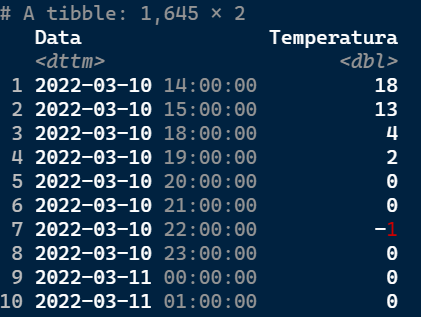Hello,
I hope this serves your needs:
library(collapse)
library(data.table)
data <- fread('dataframe.csv', select = c(2,3))
# 1st step: subsetting and identifying clusters of 6 or more consecutive hours
the_hours <- data |>
fmutate(
diff = Data - shift(Data),
flag = fcumsum(
fcase(
is.na(diff), 0L,
diff == 1, 0L,
default = 1L
)
),
length = GRPN(flag)
) |>
fsubset(length > 5) |>
# EDIT: add day variables to make IDs by day
fmutate(day = lubridate::as_date(Data)) |>
# EDIT: new grouping variable to avoid conflicts intraday (e.g. a one hour gap)
(\(x)x[ , id := .GRP, by = c('day','flag')])() |>
fselect(id, Data)
# 2nd step: get only those dates, which are in a group of 3 consecutive days
the_dates <- data |>
(\(x) x[the_hours, on = 'Data'])() |>
fmutate(day = lubridate::as_date(Data)) |>
fsummarise(day = funique(day)) |>
fmutate(diff = as.numeric(day - shift(day)),
flag = fcumsum(
fcase(
is.na(diff),0L,
diff == 1, 0L,
default = 1L
)
),
length = GRPN(flag)) |>
fsubset(length > 2) |>
fselect(day)
# 3rd step: match the relevant days and the relevant hours and apply condition
result <- data[the_hours, on = 'Data'] |>
fmutate(day = lubridate::as_date(Data)) |>
(\(x) x[the_dates, on = 'day'])() |>
# filter for clusters of 6 1s
fmutate(
temp_flag = fifelse(Temperatura %inrange% c(21,29), 1L, 0L)
) |>
fgroup_by(day, id) |>
fsubset(temp_flag == 1) |>
fungroup() |>
fgroup_by(id) |>
fmutate(
# weird things happen if stated in a single line
shift_Data = shift(Data),
diff = Data - shift_Data,
diff_greater1 = fcumsum(fifelse(diff > 1, 1L, 0L, na = 0L))) |>
fungroup() |>
ftransform(
temp_flag = fcumsum(temp_flag, list(id,diff_greater1))
) |>
fgroup_by(day) |>
fsummarise(
consec_hours_inrange = fmax(temp_flag)
) |>
fungroup() |>
fmutate(more_than_six = fifelse(consec_hours_inrange > 5, 1L, 0L)) |>
fsubset(more_than_six == 1L) |>
# filter for groups of 3 or more days again
fmutate(diff = as.numeric(day - shift(day)),
flag = fcumsum(
fcase(
is.na(diff),0L,
diff == 1, 0L,
default = 1L
)
),
length = GRPN(flag)) |>
fsubset(length > 2) |>
fselect(day, consec_hours_inrange, flag) |>
fgroup_by(flag) |>
fsummarise(
total_days = lubridate::interval(start = fmin(day), end = fmax(day))
) |>
fungroup()
# 4th step: Split the interval into chunks of length 3 days
intervall_splitting <- function(interval,period = 3){
# get start and end date
beginning <- lubridate::as_date(lubridate::int_start(interval))
ending <- lubridate::as_date(lubridate::int_end(interval))
# get the difference as a number of days
difference <- as.numeric(ending - beginning)
# number of duplicates to create the intervalls within
data.table::data.table(
start = beginning
) |>
tidyr::uncount((difference - period + 1)) |>
collapse::ftransform(
start = start + 0:(period - 1)
) |>
collapse::fmutate(
end = start + period
)
}
result |>
# if there were more than 1 interval
rsplit(~ flag) |>
rapply2d(intervall_splitting, period = 3) |>
unlist2d() |>
# apply points
fmutate(points = 20L) |>
ftransform(points = fcumsum(points))
#> .id start end points
#> 1 3 2022-04-24 2022-04-27 20
#> 2 3 2022-04-25 2022-04-28 40
#> 3 3 2022-04-26 2022-04-29 60
Created on 2022-09-24 by the reprex package (v2.0.1)
It might be a bit overcomplicated, but in the end you know at which consecutive 3 days you have had at least 6 continous hours (e.g. time intervalls without breaks inbetween) with the temperature between 21 and 29 degress celcius.
If this is not the desired result, you might be better off providing a result you wish and specify your question even further, so that I (or someone else) can help you better.
Kind regards
Edit: As pointed out by @Sfdude, there was a slight issue regarding the counting of 6 consecutive hours in range. I grouped by day, but on April 15th there was an one hour gap between 10:00 and 12:00 and on July 7th there was also a 7 hour gap which broke my fcumsum() solution. Additionally, I didn't think about a situation where the temperature drops/rises in between out of range (which is also the case on April 15th).
The adjustments above fix the issue by adding an id for every group of consecutive hours within days, so that I can group by consecutive hours within this days. This should have fixed the issue.
